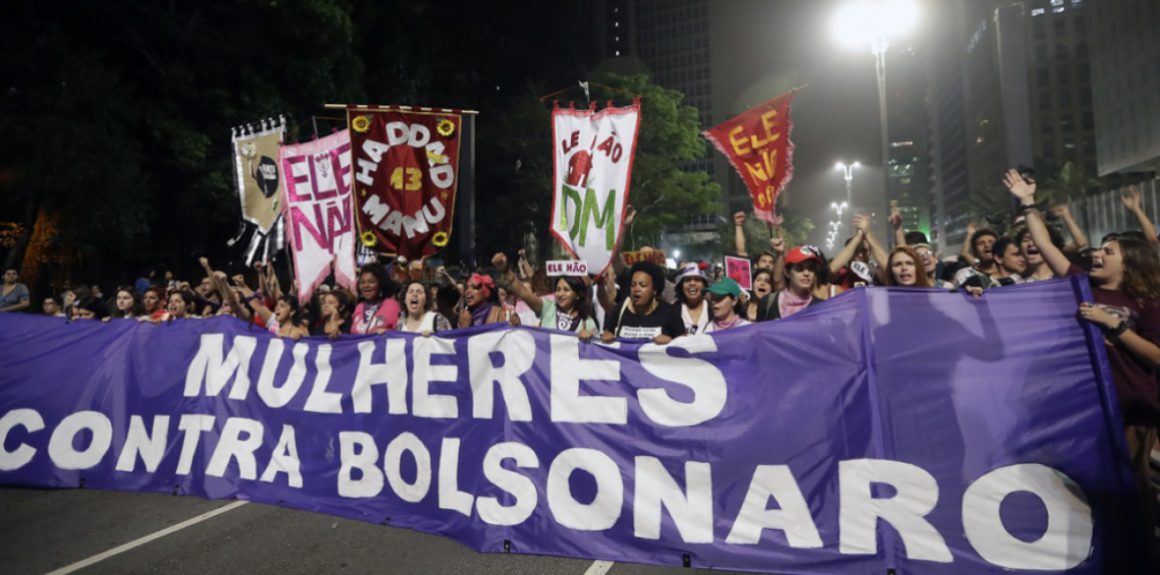The election of Jair Bolsonaro in Brazil’s Presidential election is an important warning of the growth in support for the far right and right-populism across the world. His election by a 10% margin will mean the formation of the first far-right government in the country since the military junta ended in 1985. Kevin Henry looks at how the threat of racism and the far right can be challenged and defeated.
Bolsonaro’s ultra-reactionary ideas speak for themselves. The former army captain under the military junta has claimed that both the dictatorship of Pinochet in Chile (responsible for the murder of at least 3,000 people, possibly even multiples of that figure), and the Brazilian junta itself (renowned for its use of torture), did not kill enough people. In interviews, he is quoted as saying, “I’ve got five kids, but on the fifth I had a moment of weakness and it came out a woman”, and that he “would be incapable of loving a homosexual son”. Adding that he “would prefer that my son die in an accident” than be gay.1
At the same time, Bolsonaro is pushing forward an aggressively neo-liberal programme that involves attacks on the living standards of the poor and the working class in Brazil. Scientists have also expressed concern about his intention to kick environmental NGOs out of the country. He wants to plough through Brazil’s Amazon, Earth’s biggest and most diverse tropical rainforest, which helps absorb CO2 emissions. As the Brazilian sister organisation of the Socialist Party – Freedom, Socialism & Revolution (LSR) – put it, “Bolsonaro represents the unity of radical neo-liberal policies and proto-fascist practices, the worst possible combination for the vast majority.”2
A global threat
Bolsonaro, of course, is not an isolated phenomenon. Since the election of Trump, in particular, there have been important electoral victories for the racist right and far right in Europe. In Hungary, the general election earlier this year saw the re-election of Viktor Orbán’s far-right Fidesz party, winning 49.8%, and the outright fascist Jobbik party winning 19%. In Austria, the 2017 election was won by the right-wing Austrian People’s Party, led by Sebastian Kurtz, with 31.5%. They formed a government with the far-right Freedom Party, which won 26%. This has already had the effect of significantly whipping up Islamophobia in Austria, including attacks on its Muslim population.
In Italy, the 2018 general election saw the League, led by Matteo Salvini, come out on top with 37%, followed by the populist Five Star Movement with 32%. Salvini has spoken of the need to increase the level of deportations and the government has refused to allow an NGO-operated rescue ship for refugees crossing the Mediterranean to dock in Italy.
In these countries, the far right has become not simply a prominent force of opposition, it is now a player in government. In other countries, the far right have also made important breakthroughs. In September, the racist Sweden Democrats increased their vote to 17.9% in the general election, their highest vote ever. The German election a year earlier saw the right-wing populist Alternative for Germany (AfD) enter the Bundestag for the first time as the third-largest party. The danger of this growth was illustrated by a recent protest in the city centre of Chemnitz, where the right wing mobilised thousands, cynically using the murder of a young worker to whip up tension around immigration.
Why the growth?
In order to combat the growth of these far-right and racist forces, it is essential we have a clear understanding, not just of the nature of these parties but, crucially, of the basis for their growth. A key reason for this is the crisis of and demise in support for the “extreme-centre”, the main establishment parties in the form of the traditional right and the former parties of social democracy, such as the Labour Party in the south of Ireland.
These parties are paying a political price for the implementation of austerity over a long period of time and, in the case of the latter, their historic sell-out to neo-liberal capitalism in the early 1990s. The rise of the Sweden Democrats this year coincided with the Social Democrats in Sweden having their worst election result for more than 100 years, while the main right-wing party, the Moderates, did even worse.
This process was demonstrated graphically in the French presidential elections in 2017, which saw the ruling Socialist Party getting only 6.9%. The second round saw a run-off between the current President Emmanuel Macron, who presented himself as a break with the politics of the past, and the far-right Marine Le Pen. Le Pen was able to win millions of votes from angry workers and young people with her anti-establishment and protectionist rhetoric, constantly claiming that she represented “the people” and a new approach, while at the same time playing the anti-immigration and Islamophobia cards.
This is also an important feature in Brazil. As LSR pointed out, “An important part of Bolsonaro’s vote comes from a social and economic elite which has learned its whole life to hate the poor, black people, women, North-Easterners and LGBT people.” However, they go on to say that, “the vote given to the far-right also reflects in a terribly deformed way, the indignation and tiredness of a section of the population, lacking in political alternatives and totally disillusioned with the political system and direction of the country.” Brazil is in the midst of a sharp economic crisis, alongside corruption scandals which implicated the whole political establishment and were used as a pretext for a parliamentary coup which put a right-wing president, Michel Temer, in power.
The ideologues of the “centre”, i.e. the capitalist establishment, respond to this phenomenon by equating the growth of the forces of the left and the growth of far-right and right-populist forces. This was summed up in the recent speech of ‘anti-Brexit campaigner’ Gina Miller to the British Liberal Democrat conference: “The fascism of the left is every bit as terrifying as the destructive fascism of the right.” Similar points have been made elsewhere by prominent figures, including Leo Varadkar.
Such a notion completely understates the real effect that the far-right are having on the lives of refugees, immigrants, LGBTQ and working-class people in general. More fundamentally, it ignores the role of the political establishment in creating fertile ground for these forces, in terms of their destructive austerity policies, but also the racism they are prepared to inject into the situation when it suits their interests. This doesn’t undercut the far right, but only serves to embolden them. Recently, Islamophobic comments by Boris Johnson, comparing women who wear the Burka to “letter boxes” and “bank robbers”, have led to a rise in Islamophobic attacks on women.3
Left challenge needed
Comments such as Gina Miller’s also illustrate that capitalist politicians’ real fear is the growth of a socialist challenge to their system. The Marxist revolutionary, Antonio Gramsci, commented that, “The crisis consists precisely in the fact that the old is dying and the new cannot be born; in this interregnum a great variety of morbid symptoms appear.”4 This is pertinent today. To simply look at the question of the growth of the far right without also seeing the important re-growth in support for left forces would be to draw unnecessarily pessimistic solutions. It is important to have a sense of proportion and, most importantly, an assessment of the real balance of forces in society, which in general is favourable to the left.
In Britain, the far right have been able to organise their largest demonstrations in decades, involving up to 15,000 people, under the banner of the Football Lads Alliance led by Tommy Robinson. Yet these demonstrations are dwarfed in comparison to the 250,000 who took to the streets of London when Trump visited, in large part to reject his racist agenda, or protests of a similar size that have taken place to defend the NHS. In Brazil, an opinion poll showed that 69% of people think democracy is the best form of government, compared to only 12% who said that in certain circumstances a dictatorship is best. We can expect that Bolsonaro’s agenda will be resisted on the streets.
The far right are also on the back foot when it comes to the important mobilisations and shifts in attitudes that have happened as a result of the global women’s movement and struggle for LGBTQ rights. A section of the far-right attempt to cynically use these issues; for example, claiming to stand up for the rights of women, while in reality whipping up racism, particularly Islamophobia. However, it is more common now for the far right, particularly the ‘Alt-right’, to attack these progressive movements.
This can be seen with figures like Jordan Peterson and Milo Yiannopoulos, who have come to prominence by speaking against feminism and “cultural Marxism.” They particularly attack trans* people, including through the dangerous practice of ‘doxxing’, outing people, particularly at universities. Such practices make them extremely dangerous and will assist them in recruiting a minority of transphobic, homophobic and sexist individuals. However, it also important to recognise they are taking these issues up from a position of weakness, not strength, given the shift in attitudes that has taken place in society, particularly among young people.
Why a left challenge is needed
A combative, socialist left is best placed to politically take on right populism and the far right. The fact that Jeremy Corbyn was successful in winning back a section of the Labour vote that went to UKIP is an indication of that. Similarly, Bernie Sanders would have been better positioned to challenge Trump’s claim to stand up for ordinary people than were the establishment politics of Hillary Clinton.
This can also be seen in its negative sense – where the radical left is seen to be part of the establishment, they can lose support to the far right. This is true in Germany, where Die Linke (the Left party) has lost support in the eastern part of the country and AfD have increased their vote. This has provoked an important debate in Die Linke. One of its leaders, Sahra Wagenknecht, has launched a new project called ‘Aufstehen’ (Standing Up). She has drawn the wrong conclusions as to why workers have not supported the left but have given their electoral support to organisations like the AfD.
She fails to recognise that a key reason for Die Linke losing support in the east is its involvement in local government coalitions that have implemented austerity. Wagenknecht’s focus is on calling for restrictions on migration and she has distanced herself from large anti-racist demonstrations. Such an approach will not defeat the AfD. It is absolutely necessary for socialists to be sensitive to concerns some workers have in relation to immigration and not broadly label them as being racist, as some on the left do. This means putting forward a programme that demands investment in homes, jobs with decent pay and conditions and public services to meet the needs of all working-class people, migrant and non-migrant alike. Alongside a principled opposition to racism, such a programme argued by a mass left party can cut across support for the racist and populist right.
A confident approach by the socialist left means to challenge racism and the far right in all its forms. Mass mobilisations can play an important role. The rise of Trump and the confidence given to the Alt-right as a result means that the far right looks to the US for inspiration and guidance, but so should those serious about challenging racism and fascism.
Last year’s Unite the Right demonstration in Charlottesville was a show of strength by the Alt-right. One anti-fascist was killed and the events of that day, as well as Trump’s response of equating the violence of the Alt-right with anti-fascists, provoked serious mobilisations. In Boston, 40,000 marched at short notice against another mobilisation of the Alt-right. The same happened in other major cities. While the threat of the Alt-right has not gone away, this year’s Unite the Right event was tiny. Alt-right organisations are in crisis and figures associated with them, most notably Steve Bannon, have been removed from Trump’s administration.
It was the tactic of mass mobilisation, not of street fighting ‘AntiFa’ groups, which was key to this development (though physically confronting fascists can be a necessary tactic in preventing them from organising). The same is true in Germany, where tens of thousands have mobilised to challenge the far right. Linked with that is the need to provide an alternative to the far right and the system of racism that drives it.
Ireland and the threat of racism
Ireland is not immune from the dangers posed by the growth in support for right-wing populism. The increase in support for Peter Casey from 1% to 23% in the Southern presidential elections is an important indication of this. A key reason for his increased support was his reactionary comments about Travellers and, to a lesser degree, those on social welfare. In reality, Casey was echoing similar attacks that have been made on both these groups in society by prominent figures in the capitalist establishment.5
A Red C exit poll found that 34% indicated that the main reason that they voted for him was due to his stances on “political and social issues”, while 32% voted for him because of his “ability to stand up for ordinary people.” This shows how the cynical demagoguery of Casey and his ilk can gain a foothold in society if a left-wing alternative is not built. As the Socialist Party has pointed out, such an opportunity was missed in late 2014, when those trade unions linked with the anti-water charges movement refused to launch a new left force at the height of this battle.
In the North, the dangers can be seen in the activities of group like Britain First. Coinciding with protests by the Football Lads Alliance in Britain, several hundred have marched in Belfast in a protest organised by Britain First and loyalist councillor Jolene Bunting. These demonstrations have comically attempted to portray themselves as cross-community, with Irish tricolours appearing on the demonstrations alongside the Union flag.
However, to build a base, these organisations will come down on one side of the sectarian divide. Britain First will naturally focus on attempting to build in Protestant working-class communities. More recently, they have focused their campaigning efforts in Ballymena, claiming to “stand up for the silent majority” and, in particular, playing on people’s concerns over the lack of jobs and of housing. In the North, anti-racists need to be firmly cross-community and be able to intervene in both communities. The intervention of dissident republican organisations in these protests has been to attempt to turn this issue into a sectarian battleground. This will only assist the far right.
The trade unions, which organise Protestant and Catholic working-class people, have a responsibility to play a central role in resisting the far-right. It is particularly welcome that NIPSA, one of the largest unions in the North, has taken an initiative to organise a trade union network against racism and fascism. Important mobilisations have taken place against the far right. This is important to send the clear message that they will not go unchallenged.
However, if these forces are to be defeated, confronting them on the streets is not enough. This is as true here as it is across the globe. Capitalism offers only a future of increased exploitation and an assault on our living standards. A socialist alternative that unites all working-class and young people in a common struggle against this system is needed so that racist and right-wing forces are prevented from rearing their ugly head.n
Notes
1 Benjamin Butterworth, “Jair Bolsonaro: 17 quotes that explain the views of Brazil’s fascist president-elect”, www.inews.co.uk l 2 LSR (CWI in Brazil) statement, “Brazil: Mobilise to defeat Bolsonaro and re-build a Socialist Left!, www.socialistworld.net l 3 Lizzie Dearden, “’Letterbox’ insults against Muslim women spike in wake of Boris Johnson comments”, www.independent.co.uk l 4 Antonio Gramsci, Selections from the Prison Notebooks of Antonio Gramsci, ed. and trans. Quintin Hoare and Geoffrey Nowell-Smith, Lawrence & Wishart, 1971, p276 l 5 For more on Peter Casey read the Socialist Party statement: “Presidential election result the socialist alternative to racist populism”, www.socialistparty.ie












